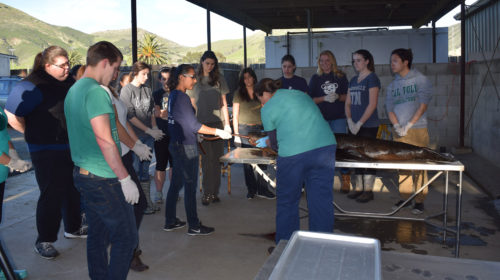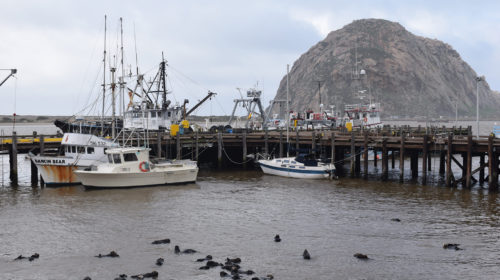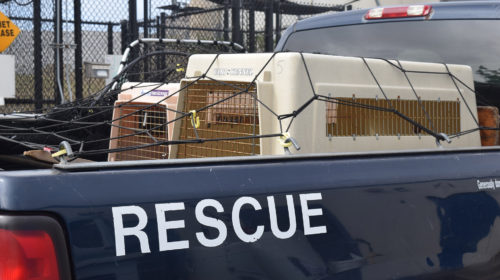A few weeks ago, I came across a press release on Cal Poly’s website about the conclusion of the first quarter of the university’s new Marine Science degree. Since the program had just finished up its first quarter, I thought that it would be a great idea to do an article for project #2 talking about how successful (or unsuccessful) the quarter had been for the faculty and for the students. After talking over the idea with my team members, Monica Roos (Editorial), Dylan Ring (Broadcast) and Savannah Sperry (Multimedia) during class, they were all excited about the prospect, as the project would allow for plenty of audio and visual opportunities.
Further research led our group to find an article published from the Tribune about the Marine Mammal Class that just began winter of last year. The class, offered through the Animal Science department, allows students the opportunity to go out to the Marine Mammal Center located in Morro Bay six hours a week to participate in the rescue and rehabilitation of sick sea lions. This allowed us to focus our topic from the marine science degree to one specific class, and why students are interested in that one specific class and the value that they see in this class.
We found out that the class, taught by Cal Poly professor and Central Coast Veterinarian Heather Harris, is only taught every winter quarter, so we immediately contacted her. Upon reaching out, we found that she was unavailable to be in contact due to an international vacation until February 12th, meaning that we had to push the story back until project #3. In the meantime, we focused on the Current Solutions story for project #2.
When the time came for project #3, our team once again reached out to Professor Harris. She agreed for an interview before the class lecture Wednesday afternoon, and encouraged us to stay for the lecture from 4 to 6, which she gave us details and a walkthrough about in an email before we arrived that day. The opportunity did not present itself for us to interview Dr. Harris that day due to her having to lead the necropsy, so we had to reschedule her interview for the following week.

I posted forums on Reddit, Facebook, and Twitter earlier that week to gage student feedback on the topic, and although the responses were few, it helped the rest of the team with coming up with questions to ask Diana Kramer, Coordinator of the Marine Mammal Center, Saturday morning.
“After posting on social media, I was a little worried that the story might fall through due to a lack of potential interest from readers. But as we began talking to different sources, I felt more confident that this is a story that pertains to everyone and resonates the importance of being bigger than ourselves,” Alison Stauf said.
We spent Saturday morning at the Marine Mammal Center in Morro Bay interviewing Diana and getting an up-close look at the work students and volunteers do at the center. We were also lucky enough to meet Trisha and Brittany, two volunteers at the center who work with Diana. Unfortunately as we were leaving a possible ride-along opportunity presented itself, as Trisha and Brittany received a call about a possible sea lion on the road side that needed to be rescued. They informed us however, that many times the calls turn out to be false alarms.



On Monday, Dylan received a message from Diana about a sea lion that had just been rescued and relocated to the Marine Mammal Center in Morro Bay. Because Dylan was unable to film anything on Saturday, it was the perfect opportunity to get footage of students working on an animal at the center. Just before we were sent to depart for Morro Bay, Diana informed us that we would need consent in order to film. Due to this, Dylan’s broadcast element of the story had to be postponed until further notice.
“This project was pretty stressful due to the sporadic nature of my part. But I thought we had a really engaging interview with Diana. You could really tell that she’s passionate about these animals. She had some great anecdotes about rescues and other encounters,” Dylan Ring said.
After reconnecting with Dr. Harris following Wednesday’s necropsy, Monica and I scheduled an interview for the following Wednesday afternoon. The interview took place at the Cal Poly Veterinary Clinic in the same classroom where the students from the class attend lecture each week.
Dr. Harris shared her favorite marine mammal memory with Monica and I, in which a young sea otter pup was reunited with its mom after drifting off during high tide. The video from Morro Bay, which was taken on Dr. Harris’ phone, went viral within hours.
“You’re not really supposed to anthropomorphize or put your human emotions onto wildlife but in this case it was impossible not to. She was just totally relieved, she had lost her little guy. It was pretty amazing to be a part of that,” Dr. Heather Harris said.
The interview with Dr. Heather Harris was the last piece that Monica and Savannah needed to complete their multimedia and editorial pieces.
“This story reminded my why I love journalism so much. Throughout my college career I’ve done tons of stories, and of course you’re not going to love every story you do. From the first day we went to the Marine Mammal Enterprise class, I felt that passion for curiosity, and each interview went so well because I had an honest interest, and so many questions. Hearing about how these students and volunteers have such great experiences has made me want to look into volunteering at the marine mammal center,” Monica Roos said.
“All in all I found this story to be challenging but rewarding. I wasn’t very familiar with multimedia going into the project but found myself more easily navigating the programs by the end. I think the Marine Mammal Enterprise class is a really interesting course and is an awesome opportunity for students. Diana and Heather were great sources and I enjoyed being able to spend some time at their Morro Bay Facility,” Savannah Sperry said.